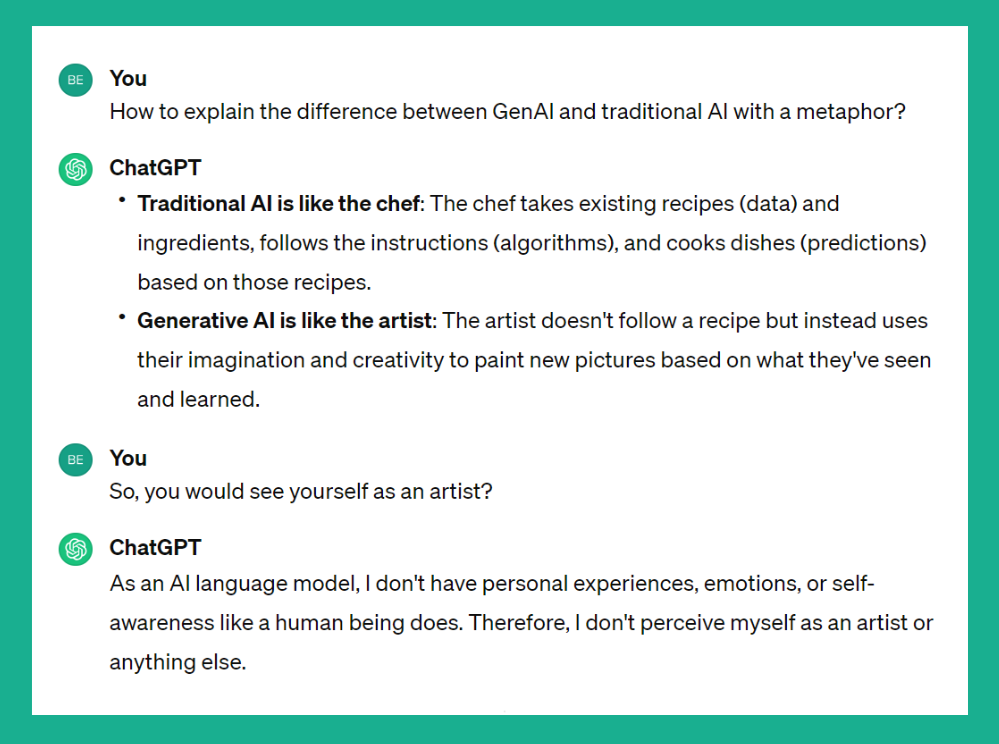Paving the way for leveraging Generative AI in your organization

Over the past year, Generative AI has emerged as a transformative force, offering new opportunities for businesses to automate redundant processes, streamline their workflows with personalized content creation, and accelerate innovation.
However, harnessing the power of GenAI requires a bottom-up approach, evaluating the different use cases inside the organization, and assessing the technology and data needed to enable these use cases.
Ready to make the most of GenAI? In this first article, we discuss how to prepare the ground in your organization for a sound GenAI strategy. In a second article, we’ll delve into the intricacies of integrating GenAI into your organization's tech ecosystem efficiently.
What does Generative AI bring that's new?
Generative AI is not the first innovation to shake up the world of IT. Not so long ago, the most pressing challenge for organizations was to leverage Machine Learning technologies in their current tech ecosystem.
So, what does GenAI bring that is new? What is its added value for a business, compared to any other technology?
The specificity of Generative AI lies in its title. GenAI is capable of producing new data and new content, such as images, text, or even entire scenarios, based on patterns learned from training data. Even though traditional AI is already sophisticated when it comes to making predictions or recommendations, it typically produces outcomes based on an existing dataset. Generative AI, on the other hand, can “take inspiration” from its training dataset and create something new.
Still a bit too abstract? Let’s ask ChatGPT to provide us with an easy-to-understand metaphor to describe the difference between GenAI and traditional AI.
 The difference between GenAI and traditional AI... According to ChatGPT
The difference between GenAI and traditional AI... According to ChatGPT
On the same page, and to go deeper into the topic, this interesting article by Forbes compares AI to “an imaginative friend who can come up with original, creative content”.
Far from being a mere gadget, this new form of AI can be used by organizations in a host of ways to achieve their goals and accelerate their innovation.
There's no shortage of examples. In the retail and e-commerce industry, for instance, Generative AI can be used to create realistic product images for e-commerce platforms. For instance, a clothing retailer could generate images of models wearing different outfits, showcasing their products in various styles and settings. Retail companies can also leverage generative AI to design personalized products for customers.
Are you curious to learn more about all the possible use cases of GenAI? In this blog post, IBM offers a good summary of the different ways in which companies are already using GenAI technologies.
Implementing GenAI in your tech ecosystem

Define your scope for GenAI implementation
Let’s start by a reminder that applies to IT modernization in general. Just because a new technology emerges doesn’t mean you should feel obligated to adopt it within your organization. If, on the other hand, you realize that Generative AI can help you better achieve some of your key goals, and open up growth opportunities, then it’s time to implement a GenAI strategy.
Feels like stating the obvious? Maybe, but it will allow us to focus on what matters. Before thinking about “how should I integrate GenAI into my existing technology stack?”, the initial question is: “where does it make sense to integrate GenAI?”.
This relates to initiatives that are already part of traditional Enterprise Architecture Management:
- Having a clear picture of the different business capabilities within the organization
- Understanding what business goals are achieved by each unit
- Understanding the technology stack that supports each business unit
With this knowledge, it becomes possible to identify areas where GenAI integration would be beneficial, and start planning the first business cases.
So, what are we trying to achieve?
We were about to name this section “stay aligned with the business”. But you probably know it already: embracing GenAI technologies is not just about integrating cutting-edge tools into your existing tech ecosystem; it's about ensuring alignment with the goals and needs of the business.
So, instead of common statements about the importance of working together with all stakeholders, let’s go a step further and ask ourselves: how to make sure everyone is happy at the end of the project?
As it is about achieving business goals, the discussion at the early stages of the project should focus on the outcomes. “We want to integrate this GenAI technology into our recruitment platform” is not enough to build a viable process. The question is: what do users want to achieve with this technology? Is it automating the creation of job offers, or to better source candidates?
The second advice would apply not only to GenAI implementation, but also to project management in general. Things become clearer when we look a few months ahead, and formulate what we want to observe at that time. Therefore, a good way to align on a common vision is to ask users: “We are six months from now, and the integration is a complete success. What has been achieved? What makes you satisfied with this new integration?”.
Ready, set, go!
We hope you enjoyed this article. We’re coming back very soon with a second post on the same topic, going deeper into the intricacies of GenAI implementation in your current tech ecosystem!
In the meantime, you can learn more about how the Txture platform can help you accelerate your cloud modernization and efficiently integrate GenAI in your IT landscape.
Related posts
29.4.2025Application ModernizationDefine your scope for IT modernization2.3.2025
Cloud StrategySelecting the right cloud data center for hosting your workloads27.6.2024
Cloud optimizationA great driver to maximize cloud value: moving to instances with modern processors 24.5.2024
Cloud Knowledge5 best practices to manage change during a cloud transformation5.4.2024
Generative AIHow to welcome Generative AI into your existing tech ecosystem
